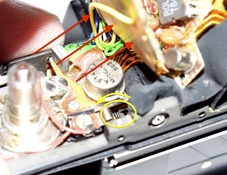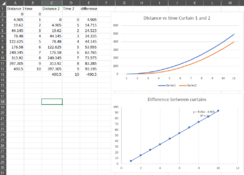Curtain-travel times and shutter speeds: First use of the Reveni Labs Camera Tester
After having familiarized
myself with the Reveni Labs Camera Tester, today I want to adjust the horizontal focal plane shutter on my Minolta XG-M.
The speed of the two curtains will not be correct, as I had already played around with the adjustment wheels for the curtain tensions.
I take the curtain-travel times from the SPT Journal:
Society of Photo-Technologists Journal
learncamerarepair.com
For the tester, I convert it from 32 mm to 36 mm sensor distance:
=> Target curtain-travel time is 12.4 ms.
I measure the shutter speeds per sensor (L, M, R) and the curtain-travel times (C1, C2) for 1/1000 second.
1/60 s
1/4 s
The tester optionally displays the shutter speeds as fractions, which I am more familiar with.
Since I did not photograph the corresponding displays, I convert the shutter speeds myself and use the values of the middle sensor (M):
=> 1/4.4 s, 1/54 s and 1/685 s
The result shows that the values for 1/4 s and 1/60 s are close to the target values. At 1/1000 s the shutter speed is clearly too long although the curtain-travel time is ok.
Since I have no experience and would like to gain some here, I will try to set the curtain travel time on the camera for 1/60 s in the first step.
The aim is to get both curtains to have a curtain-travel time of 12.4 ms. Currently they are running too slowly.
Making settings on the XG-M
To reach the two adjustment wheels for the curtain tensions, I remove the base plate and desolder the plate with the battery chamber.
Then I connect the disconnected power supply to the camera via cables.
I have to be careful not to short-circuit the plus and minus. There isn't much space on the circuit board.
Here are the two ratchet gears for setting the curtain tensions.
To adjust the lower one, I have to loosen a crocodile clip.
Since both curtains move too slowly, more tension is needed here, which is transferred to the curtains via rubber bands. So I have to turn the ratchet gears until they are locked in place.
Of course, I turn the wheels in the wrong direction by releasing the catches. Now the shutter won't open at all.
The patience game begins

First conclusion
- Working with the Revenu Camera Labs Tester is the easier part.
- Setting up the XG-M requires some effort. But that doesn't surprise me, as the Minolta Repair Manual describes some setting procedures where test devices are connected and resistors are soldered into the circuit. The bread and butter of service technicians in the early 1980s

- Interpreting the measured values requires experience. It is about optimization, not about achieving 100%.
- If the curtain travel times are correct, the shutter speeds should also be OK. These are generated electronically and I didn't mess around with the potentiometers responsible for this when I replaced all the electrolytic capacitors. The factory settings should therefore be retained.
- This is not for the impatient. So we'll have dinner now and continue tomorrow





















